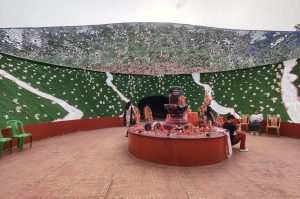Durga Puja Economy in Bengal 2025: Durga Puja is not only a spiritual and cultural celebration in West Bengal but also a massive seasonal economy that drives trade, commerce, and employment. In 2025, Bengal’s Durga Puja economy has touched an unprecedented ₹65,000 crore, with Kolkata alone contributing nearly 70%. This growth is significant given challenges like unpredictable rain, consumer hesitancy over GST reforms, and the rising dominance of malls over traditional markets.

Official estimates by trade bodies, alongside government studies on festival-related economies, affirm how Puja contributes a sizable share to the state’s Gross State Domestic Product (GSDP). In fact, earlier studies commissioned by UNESCO and the British Council had already marked Kolkata’s Durga Puja as an Intangible Cultural Heritage of Humanity, recognizing its role beyond festivities.
👉 Ministry of Culture – UNESCO Intangible Cultural Heritage of Humanity
👉 Government of West Bengal – Department of Micro, Small & Medium Enterprises
Durga Puja Economy in Bengal 2025: Kolkata at the Heart of Puja Spending
Kolkata continues to dominate Bengal’s Puja economy, with 2,500 Puja committees spending nearly ₹200 crore on idols, lighting, pandals, and rituals. This spending acts as a catalyst for sectors ranging from artisans and electricians to decorators, carpenters, and sound engineers. The city’s malls, restaurants, hotels, and transport systems also witnessed unprecedented surges in revenue during the festival period.


District-level celebrations contributed the remaining ₹20,000 crore, but the imbalance in spending highlights the urban-centric nature of Puja-driven commerce.
Sector-Wise Impact: Food, Fashion, Retail, and Artisans
Food & Beverage Boom
Restaurants, cafes, and food delivery platforms reported revenues of ₹1,200–1,500 crore, with Kolkata generating over 60%. The festive rush led to record footfalls in leading eateries, demonstrating how food remains central to Bengal’s festive culture.
👉 Ministry of Tourism – Incredible India
Retail and Fashion: Malls vs. Traditional Markets
- Malls: Kolkata’s eight major malls recorded business of about ₹900 crore during the Puja period, showing 8–10% growth.
- Traditional Markets: On the other hand, iconic bazaars like Gariahat, Hatibagan, and New Market faced nearly 20% decline in sales. Rainfall and GST-related uncertainty dampened consumer enthusiasm, driving more people toward malls and online shopping platforms.
👉 Goods and Services Tax Council – Government of India
Artisans and Idol Makers
The Puja economy sustains thousands of artisans in Kumartuli and rural belts. The idol-making industry, alongside lighting and pandal design, forms a cultural backbone. Yet, despite large committee spending, smaller artisans often face delayed payments and shrinking profit margins due to uneven distribution.
👉 West Bengal Handicrafts Development
Headwinds: Rain, GST & Unequal Distribution
Rain Disruptions
Persistent rainfall in the pre-Puja weeks hampered shopping activity in traditional markets and reduced footfall at smaller fairs and stalls. Many shopkeepers complained of compressed sales windows.
GST Transition
With new GST revisions pending, many small traders and consumers hesitated to make large purchases. Confusion about slabs on garments, accessories, and electronics curtailed spending power in traditional markets, hitting micro-entrepreneurs hardest.
Urban-Rural Disparities
While Kolkata thrives, rural districts and suburban Puja committees struggle with limited sponsorships and smaller consumer bases. This imbalance leads to concentrated economic benefit rather than inclusive growth.
Employment, Livelihoods, and Social Impact
Durga Puja provides temporary employment to thousands of workers: decorators, electricians, carpenters, security personnel, lighting designers, and event managers. The ₹65,000 crore economy supports seasonal wages that sustain families for months.
Beyond economics, Puja also strengthens Bengal’s cultural identity and global recognition. UNESCO’s 2021 recognition of Kolkata’s Durga Puja as Intangible Cultural Heritage has further elevated its global standing.
👉 UNESCO – Intangible Cultural Heritage
Government’s Role and Policy Recommendations
The West Bengal government and central bodies have a critical role to play in sustaining Puja’s economic potential.
- Infrastructure for Traditional Markets – Improved roofing, drainage, and rain protection can safeguard vendors during Puja shopping rush.
- Support for Small Traders – Simplified GST compliance and training for small shopkeepers could reduce the burden of transition.
- Promotion of Eco-Friendly Practices – Encouraging biodegradable idols, LED lighting, and sustainable materials to meet green festival goals.
- Cultural Tourism Boost – Promoting Puja internationally through Incredible India campaigns can increase tourist inflow.
👉 West Bengal Tourism – Official Portal
Durga Puja Economy in Bengal 2025: Preserving the Spirit and Spreading the Gains
The 2025 Durga Puja economy crossing ₹65,000 crore showcases the festival’s unmatched power as Bengal’s economic engine. But the benefits are not evenly distributed — Kolkata continues to outpace rural districts, and traditional markets lose ground to malls. The dual challenge lies in making the Puja economy more inclusive and sustainable.
Durga Puja is not just a festival; it is a cultural economy, a heritage asset, and a social equalizer. Its success should not only be measured by revenues but by how equitably those revenues reach artisans, small traders, and rural communities.
With stronger policy support, rain-proof infrastructure, GST clarity, and artisan inclusion, Bengal’s Puja economy can continue to thrive as both a cultural marvel and an economic powerhouse.
👉 Government of India – Ministry of Culture
👉 West Bengal Government Portal
Also read: Home | Channel 6 Network – Latest News, Breaking Updates: Politics, Business, Tech & More

